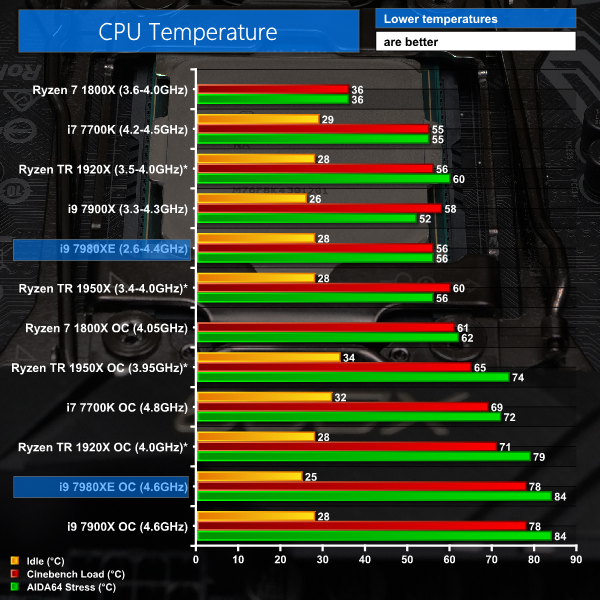Power Consumption
We leave the system to idle on the Windows 10 desktop for 5 minutes before taking a power draw reading. For CPU load results, we read the power draw while producing five runs of the Cinebench multi-threaded test as we have found it often pushes power draw and temperature levels beyond those of AIDA 64 and close to Prime 95 (non-AVX) levels.
Even five continuous loops of Cinebench results in a short run time on high-performance CPUs which influences the validity of the temperature reading, so we run 5 minutes of AIDA64 stress test to validate data.
The power consumption of our entire test system (at the wall) is shown in the chart. The same test parameters were used for temperature readings.

Here’s an update of the VID listing with the addition of power draw figures taken during Cinebench R15.
Default clocks, 1.005VID, 275W total
36x100MHz, 1.000VID, 310W total
37x100MHz, 1.030VID, 330W total
38x100MHz, 1.050VID, 350W total
39x100MHz, 1.077VID, 365W total
40x100MHz, 1.100VID, 390W total
41x100MHz, 1.124VID, 415W total
42x100MHz, 1.148VID, 450W total
43x100MHz, 1.175VID, 485W total
44x100MHz, 1.203VID, 525W total
45x100MHz, 1.203VID, 540W total
46x100MHz, 1.203VID, 550W total

At stock clock speeds the Core i9-7980XE compares very favourably with the i9-7900X and also with both models of Threadripper. When the 18-core is overclocked the power draw increases dramatically, demanding 145W more than the i9-7900X and is in the same ballpark as the overclocked TR 1950X.
Our chart of Cinebench R15 performance per Watt clearly shows the Core i9-7980XE does a remarkably good job both at stock clock speeds and when overclocked to 4.6GHz.
Temperatures

Temperatures at stock clock speeds.
Temperatures overclocked to 4.6GHz.
Here’s our final update to the overclocking table, this time with the addition of CPU temperatures.
Default clocks, 1.005VID, 275W total, 46 degrees
36x100MHz, 1.000VID, 310W total, 47 degrees
37x100MHz, 1.030VID, 330W total, 51 degrees
38x100MHz, 1.050VID, 350W total, 54 degrees
39x100MHz, 1.077VID, 365W total, 56 degrees
40x100MHz, 1.100VID, 390W total, 60 degrees
41x100MHz, 1.124VID, 415W total, 64 degrees
42x100MHz, 1.148VID, 450W total, 68 degrees
43x100MHz, 1.175VID, 485W total, 71 degrees
44x100MHz, 1.203VID, 525W total, 74 degrees
45x100MHz, 1.203VID, 540W total, 75 degrees
46x100MHz, 1.203VID, 550W total, 78 degrees
Overview
These figures are effectively identical to the Core i7-7900X which is simply remarkable as Core i9-7980XE has almost double the number of cores. Furthermore you may have noted in our video that we tested the Core i9-7980XE with a 240mm Fractal Design Celsius S24 All In One in Auto mode at stock clock speeds and simply clicked up the performance into PWM mode when we overclocked the CPU.
Previously we have used a 280mm AIO with the fan speed set to maximum which delivers a clear benefit but also makes the system horribly antisocial.
In recent times Intel has struggled to shift heat out of the CPU package so no matter what CPU cooling system you use the problem lies within the CPU, hence our decision to use a more civilised CPU cooler. Our test results suggest that Intel has updated the CPU package in some way however the rumour mill tells us that Intel has continued to use TIM inside Core i9 up to and including the 16-core model.
It would be perverse for Intel to have done something different with the Core i9-7980XE such as using liquid metal or solder so we shall return to this point when we have more information. We shall certainly test Core i9-7980XE with a selection of coolers and will have to think long and hard about delidding this US$1999 CPU to improve cooling.
 KitGuru KitGuru.net – Tech News | Hardware News | Hardware Reviews | IOS | Mobile | Gaming | Graphics Cards
KitGuru KitGuru.net – Tech News | Hardware News | Hardware Reviews | IOS | Mobile | Gaming | Graphics Cards









That’s actually better performance than i had expected. Now to see what a delidded one does on a rog rampage vi apex board 😛
Pointless CPU. 1950x all the way. Done with Intel and this confusing CPU market strategy. Perf x price is ridiculous. Only a bunch of rich richie will buy it, so they can say “look i have a freaking 7980xe”.
which is a perfectly legit reason to buy a cpu, some people get a wife just for that reason 😉
It’s too fast! Not fair! We will attack them using our paid shills to troll the social media!
Apex’s a disaster, it has only 4 DiMM slots, look for Extreme.
You don’t know what Apex is! LOL
https://www.asus.com/Motherboards/ROG-RAMPAGE-VI-APEX/
Is there a different Apex?
you dont know why it exists and why it has 4 dimm slots…you’re out of the game bro
@Eduardo : try to educate your slightly-behind-the-times techloving compadres then 😉
@Bryan : the Apex, just like the (STILL upcoming) EVGA Dark x299 board, has only 4 dimm slots because they opted not to go with expanded memory slots, what you get is the actual quad-channel memory slots. This improves the performance of the memory, and also lowers demand on the cpu’s memory controllers. This in turn allows for both higher memory speeds (up to 4266Mhz and possibly even higher) and better cpu performance. The Apex is a board for those who want to squeeze the last drop out of their system, with better memory management, better and cleaner power delivery, and all the bells and whistles a finetuning overclocker could wish for. It’s also ridiculously overpriced, but that was to be expected.
Apex is like a cutdown version of the rampage Six Extreme
How are you getting so low powerconsumption with this beast?
Eduardo Henrique
http://amdvsintel2017.blogspot.com